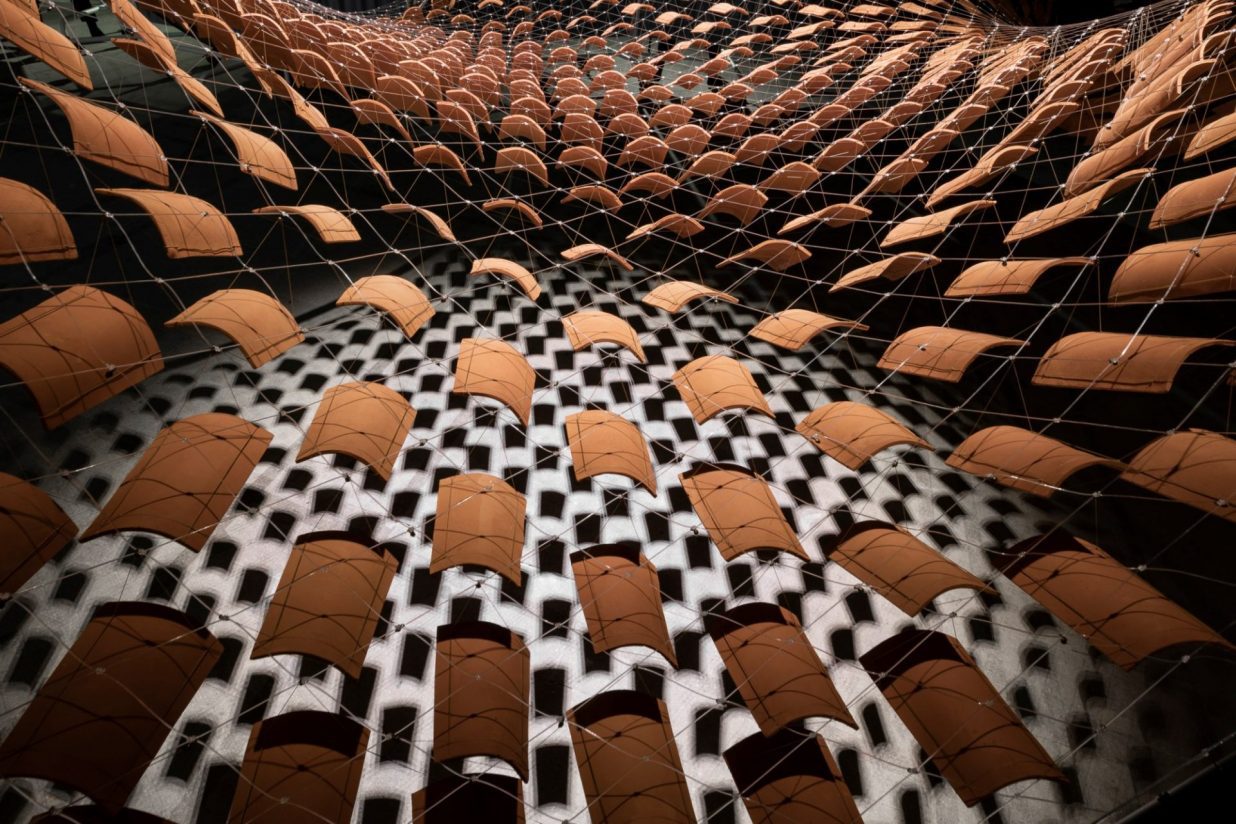Redefining Practice of Clay with Flocking Tejas
With Flocking Tejas, a Chilean design firm Base Studio has explored architectural and constructive qualities of clay tiles through an installation on display at Venice Architecture Biennale 2021. The installation triggers questions and evokes speculation about the potential of material over time in an array of cultures.
Base Studio is an architectural systems design research studio that develops architecture oriented towards non-conventional geometrical, material, and spatial formulations to accommodate the challenges and opportunities of contemporary life. With their installation using one of the most primitive of construction materials, clay, the designers at Base contemplate how systemic thinking and generative design methods contribute to new ways of living together.
“ Can they become a tool for bringing tradition and identity together in a contemporary way? Can they help to design customizable architectural strategies adaptable to diverse local accessible solutions? Can they contribute to the creation of transferable dignified spatial experiences for the many,” the designers’ Barbara Barreda, Felipe Sepúlveda, of Base ask as they expand on the possibilities of clay.

 “We believe the challenge of living together demands architecture to better deal with the complexity of individuals and communities. Through systems that can bring together past and future, techniques and technology, analogue and digital, we can begin to embrace the crossover of ‘old’ and ‘new’ as an opportunity for a more inclusive architecture. In this sense, clay tiles are part of a wide repertoire of traditional, handmade, accessible, sustainable materials that we believe can be utilised in different more complex, and provocative ways by means of contemporary design methods, establishing a technological mid-ground between tradition and design advancements,” they say.
“We believe the challenge of living together demands architecture to better deal with the complexity of individuals and communities. Through systems that can bring together past and future, techniques and technology, analogue and digital, we can begin to embrace the crossover of ‘old’ and ‘new’ as an opportunity for a more inclusive architecture. In this sense, clay tiles are part of a wide repertoire of traditional, handmade, accessible, sustainable materials that we believe can be utilised in different more complex, and provocative ways by means of contemporary design methods, establishing a technological mid-ground between tradition and design advancements,” they say.
Flocking Tejas seeks to unveil the architectural possibilities of clay tiles as a transferable strategy; as a system that can be adopted by a diversity of communities with different social, economic, cultural, and technological backgrounds.
Flocking Tejas is an emergent and adaptable architectural system arising from questioning the architectural and constructive qualities of clay tiles, and observing how, over time, in an array of cultures, their use has been conducted by construction systems of seemingly static, predictable, flat organizational principles. Flocking Tejas seeks to explore new spatial and formal repertoires, boosting the usage and possibilities of handcrafted identitarian materials and local techniques by means of global contemporary design methods.

 A system that can be adopted by a diversity of communities with different social, economic, cultural, and technological backgrounds; as an accessible, transferable architectural strategy in which people become active participants of its materialization. The system’s design allows a dynamic range of instances, variations, and architectural applications. Its intrinsic ability to create semi-open common spaces makes it essentially a social enabler that allows for inclusiveness and spatial generosity inviting communities to meet under joyful owned extraordinary spaces.
A system that can be adopted by a diversity of communities with different social, economic, cultural, and technological backgrounds; as an accessible, transferable architectural strategy in which people become active participants of its materialization. The system’s design allows a dynamic range of instances, variations, and architectural applications. Its intrinsic ability to create semi-open common spaces makes it essentially a social enabler that allows for inclusiveness and spatial generosity inviting communities to meet under joyful owned extraordinary spaces.
In the context of the Biennale, Flocking Tejas aims to trigger questions and evoke images and speculation about the spatial, social, and identitarian potential of architecture.
Details of FLOCKING TEJAS:
Architecture: Barbara Barreda, Felipe Sepúlveda
Architectural Collaborators: Miguel Reyna, Matías Ramírez, Pamela Cortez, Macarena Alvarado, Catalina Ellena, Ignacio Salinas, Rodrigo del Campo, Francisca Feliú, Martín Gómez.
Engineering: ARUP; Ed Clark, Chris Clarke
Digital Consultant: PO_LLC; Kensuke Hotta, Jiang Lai, Aqil Cheddadi, Akito Hotta
3D Mesh consultants: Carl-Stahl ARC GmbH .
Supporters:
Ministerio de las Culturas, las Artes y el Patrimonio – Gobierno de Chile.
All Images and Details Courtesy Base Studio
Photography by Raul Betti









